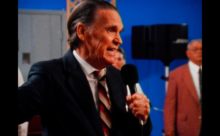Raise the Dead, Eula Shelton and the Appalachian Holiness Church by Deborah Vansau McCauley
Brad McElhinny’s four-column review of Raise the Dead in the West Virginia Charleston Daily Mail (February 1999) is titled, “Film highlights W.Va. minister’s life,” with a photo of Brother H. Richard Hall preaching in War, West Virginia. When I first glanced at the review I thought, “But Brother Hall is from Tennessee.” Then I read it. The review’s first sentence introduces not Hall but Eula Shelton. By the third sentence it is clear that the headline to McElhinny’s review refers not to Brother Hall but to Sister Shelton.
McElhinny writes, “The documentary filmmakers were relaxing in a hotel when a soft-spoken, silver-haired woman walked up and offered them possibly the most meaningful bologna sandwiches they’d ever eaten. The meal was the first step toward getting to know Eula Shelton, a McDowell County widow who became a central figure in Raise the Dead, a documentary examining the Pentecostal faith.
“The filmmakers recorded Shelton’s personal revival her story of becoming a Pentecostal preacher, starting her own church and stopping cancer treatment to prove her faith in divine healing. As for why she offered the cold cut sandwiches that day after a revival meeting in War, that’s anyone’s guess.”
Eula Shelton is part of a long tradition of Holiness preachers, women and men, going back to the Great Revival on the Appalachian frontier at the turn of the nineteenth century. Out of that period of revival emerged the Holiness and Pentecostal movements part Methodist, part Baptist in heritage. In the mountains of Appalachia, Holiness churches generally are independent, like the church Sister Eula set up in War, West Virginia. Outside of Appalachia, and for people whose understanding of religious life in the United States does not stray far from the frameworks of denominational categories, churches such as Eula Shelton’s are Pentecostal, because mountain Holiness people also practice speaking in tongues (the feature distinguishing Pentecostal denominations such as the Assemblies of God, the nation’s largest, from Holiness denominations such as the Church of the Nazarene, the nation’s oldest). Apart from these standard conventions of definition, in their own vocabulary mountain people who worship in churches such as Sister Eula’s call them Holiness, and they always have.
Appalachian Holiness people fellowship (worship) in each other’s churches, going to other Holiness churches over a wide area as often as they go to their own home church. These churches usually have no denominational affiliation at the state, regional, or national levels. Their preachers are not “ordained” after obtaining a seminary degree and serving under the jurisdiction of a denominational body, as are Holiness preachers’ mainstream Protestant brothers and sisters in the ministry. Through apprenticeship and practical experience, and by the informal authority of the local community in which they live and worship, a man or a woman comes to be recognized as a Holiness preacher. Like becoming a preacher, Holiness churches are fluid in their organizational life and even in their location, but individual churches are often long-lived, going back decades in the local community.
It is not uncommon for Holiness people, and Holiness preachers in particular, to worship in a large host of denominational and nondenominational church traditions other than their own, a tradition of fellowshipping with roots deep in the region’s religious history. Although they have never been counted in any national census of church populations because of their seeming invisibility, Holiness churches most likely make up the largest of all church traditions in Appalachia, whether Old Time Baptist (like the Old Regular Baptists, Free Will Baptists, and Primitive Baptists) or mainstream Protestant (such as the Presbyterians, Methodists, and Episcopalians). Because of their typically small size frequently less than a dozen regular members or participants, like in Sister Eula’s church independent Holiness churches tend to be regarded by those outside Appalachia, or in Appalachia’s valleys and larger towns, as no more than a blip on the region’s religious landscape. They appear to have no real, temporal power. As for their spiritual power, well, who knows?
The bonds of Appalachia’s independent Holiness people with each other are tight and strong, worshiping not just in each other’s churches but wherever the Holy Spirit leads them. People often travel several hours to worship at other churches over a large area, and usually do so more than one night a week. Holiness churches in particular hold full services mostly on week nights, which means not just on Sunday and many Holiness churches do not meet on Sunday. These worship patterns in terms of frequency, time of day, and day of week go back to the worship patterns characteristic of the Great Revival on the Appalachian frontier in the early 1800s. They are realistic patterns adapted over more than two centuries to the everyday lives and needs of people for whom communal worship is of paramount importance, however small the gathering of believers may be on any given day, or under the revival tent.
Brad McElhinny continued in his Charleston Daily Mail film review of Raise the Dead, “Shelton, 78, had a mastectomy in 1993. ‘I never took chemotherapy after that,’ she said. ‘They were making the different appointments at the hospital, and I came home and prayed and told them to cancel me; I wouldn’t be back. God has stretched my life. Yes, he has. He certainly has been good to me.’
“Shelton, who has seen part of the film,” McElhinny writes, “said she thought it would be more about Hall’s ministry. ‘It wasn’t really what I expected,’ she said. ‘I guess it’s all right.’” In typical Appalachian style, Sister Eula deferred to the work of Brother Hall, not because he is a man or more visibly prominent in the world’s eyes but in order not to do any violence to the work God would have her do, as long as she still draws breath in this life.
—Deborah Vansau McCauley
